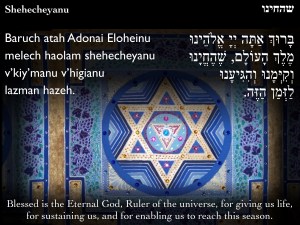Take a moment to be fully grateful for just one thing in your life. That little pause may be enough to change your outlook and your attitude for the day.
At the URJ Biennial, CCAR Press offered that opportunity with a set of stickers and a poster board featuring the book, This Grateful Heart: Psalms and Prayers for a New Day. Each of the stickers read ‘I’m grateful for…’ and folks who came by the booth could complete that line and add the sticker to the poster. Adults and kids, rabbis and cantors, educators, congregants, and lay leaders joined in. By the end of the convention, the board was covered with individual prayers of gratitude.
Gratitude for family and the Biennial appeared most often. One of my favorites came from a little girl who dictated her gratitude to her mother: “being fancy.” I got a chuckle reading “my puppy (woof).”
This is a prayer based on those stickers. I added the language in italics – as well as the punctuation and a few of my own gratitudes – and arranged the order. The words of the prayer are taken from the stickers written by Biennial attendees.
Biennial Sticker Prayer of Gratitude

We are grateful for so much,
All the gifts this world offers.
We celebrate:
The URJ, the CCAR and our congregations,
Biennial, the people, the music and the ruach,
The chance to learn and share,
Being a college ambassador
And singing in the Biennial choir.
I give thanks for:
My family,
My wonderful husband, my wonderful wife,
My children, my grandchildren,
My sons, my daughters,
Nephews and nieces,
Mom and dad,
Sisters and brothers,
My amazing boyfriend,
My fantastic girlfriend,
Thoughtful work friends,
My dog, my puppy (woof) and my cat,
My house, bed and toys,
Best friends and conversations,
Being who I am,
My camp, my nanny and my students,
Jewish music and my guitar,
You.
We marvel at the gifts of:
Dreams, spirit and creativity,
Opportunities, expected and unexpected,
Personal passions,
Good health and sleep,
The ability to grateful,
The ability to forgive,
Second chances and
Guardian angels,
Good food and better company,
Water, hugs and coffee,
Doctors, medicines and helping hands,
America,
Torah and Israel,
Books, puns, words and being fancy.
Today, Source of love and light,
We are grateful for
Every. Single. Thing.
Alden Solovy is a liturgist, author, journalist, and teacher. His teaching spans from Hebrew Union College-Jewish Institute of Religion in Jerusalem to Limmud, UK, and synagogues throughout the U.S. Solovy is a three-time winner of the Peter Lisagor Award for Exemplary Journalism. He made aliyah to Israel in 2012, where he hikes, writes, teaches, and learns. His work has appeared in Mishkan R’Fuah: Where Healing Resides (CCAR Press, 2012), L’chol Z’man v’Eit: For Sacred Moments (CCAR Press, 2015), Mishkan HaNefesh: Machzor for the Days of Awe (CCAR Press, 2015), and Gates of Shabbat, Revised Edition (CCAR Press, 2016). He is the author of This Grateful Heart: Psalms and Prayers for a New Day, published by CCAR Press in 2017.







 During the second and third year’s planning meetings, I fretted that many of those booklets had not returned to us. I was concerned about the potential chilul of where those booklets might have ended up and about the environmental waste of resources that would not be re-used and possibly not recycled. I wanted to revise some of the language we had chosen, but didn’t want to get rid of all the books we still had on hand. Some time between the third and fifth year I encountered
During the second and third year’s planning meetings, I fretted that many of those booklets had not returned to us. I was concerned about the potential chilul of where those booklets might have ended up and about the environmental waste of resources that would not be re-used and possibly not recycled. I wanted to revise some of the language we had chosen, but didn’t want to get rid of all the books we still had on hand. Some time between the third and fifth year I encountered 







